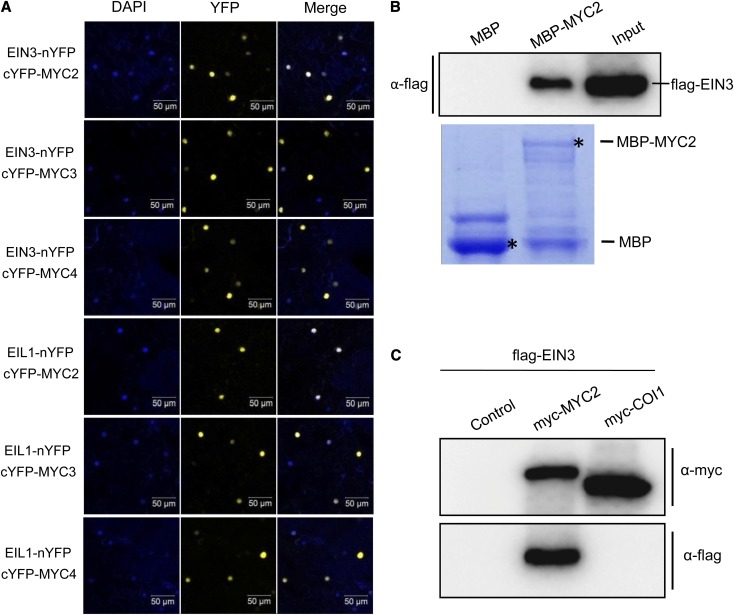Figure 4.
MYC2, MYC3, and MYC4 Interact with EIN3 and EIL1.
(A) BiFC assay to detect the interactions of MYC2, MYC3, and MYC4 with EIN3 and EIL1. EIN3 and EIL1 were fused with the N-terminal fragment of YFP (nYFP) to form EIN3-nYFP and EIL1-nYFP, respectively. MYC2, MYC3, and MYC4 were fused with the C-terminal fragment of YFP (cYFP) to generate cYFP-MYC2, cYFP-MYC3, and cYFP-MYC4. YFP fluorescence was detected in N. benthamiana leaves coinfiltrated with the combination of indicated constructs. The positions of nuclei were shown by 4′,6-diamidino-2-phenylindole (DAPI) staining.
(B) In vitro pull-down assay to verify the interaction of MYC2 with EIN3. The purified MBP and MBP-MYC2 fusion protein were incubated with the total protein from N. benthamiana leaves with transient expression of flag-EIN3. Bound proteins were washed, separated on SDS-PAGE, and immunoblotted with the anti-flag antibody (α-flag; top panel). The input lane shows the protein level of flag-EIN3 expressed in leaves of N. benthamiana. The positions of purified MBP and MBP-MYC2 separated on SDS-PAGE are marked with asterisks (bottom panel; stained by Coomassie blue).
(C) Co-IP assay to verify the interaction of MYC2 with EIN3 in planta. The flag-EIN3 was coexpressed without (Control) or with myc-MYC2 or myc-COI1 in the N. benthamiana leaves. The total protein extracts from the N. benthamiana leaves with transient expression of flag-EIN3, flag-EIN3 plus myc-MYC2, or flag-EIN3 plus myc-COI1 were immunoprecipitated with the anti-c-myc antibody-conjugated agarose and were further detected by immunoblot using anti-flag antibody and anti-c-myc antibody.

